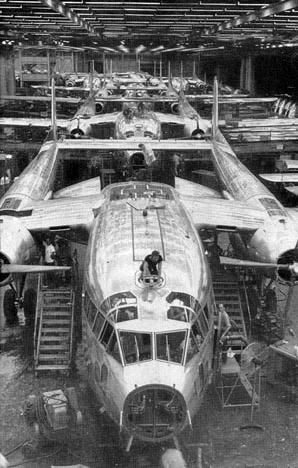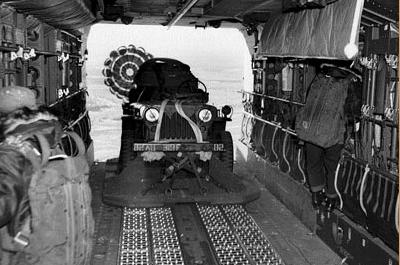The History
 The brief juxtaposition of CJ-3B and C-119 in
Flight of the Phoenix
is a small coincidence, but it brings to mind a longer history where
Jeeps and Flying Boxcars have had some things in common.
The brief juxtaposition of CJ-3B and C-119 in
Flight of the Phoenix
is a small coincidence, but it brings to mind a longer history where
Jeeps and Flying Boxcars have had some things in common.
The first link between the two was the Kaiser-Frazer Corporation, which in the early 1950's was building C-119's alongside Kaiser automobiles at its Willow Run, Michigan plant (left). At the same time it was purchasing Willys-Overland and the Toledo plant where CJ-3B's were just going into production.
As described in When the CJ-3B Was New on The CJ3B Page, Henry Kaiser appeared before a U.S. Senate committee in 1953 in a futile attempt to defend the sky-high cost of the Flying Boxcars he was building, compared to those built by the Fairchild Corporation. How did it happen that his move into a well-established airplane program was so much less successful than his takeover of the Jeep brand?
Henry John Kaiser made his fortune before World War II in shipbuilding and civil engineering. During the war he was involved with movie mogul and aviator Howard Hughes in the early development of the ill-fated gigantic flying boat known as the Spruce Goose. Then after the war he teamed with Joseph Frazer, to make cars under both the Kaiser and Frazer brand names, including the stylish Kaiser Deluxe (50K JPEG) and the unique Kaiser-Darrin 161 Roadster (see What Henry Kaiser Gave Up to Make Jeeps on The CJ3B Page.)
Kaiser-Frazer couldn't make cars cheaply enough to compete with the Big Three, which perhaps should have been a warning about competing with the big aircraft manufacturers. But Kaiser had purchased Ford's Willow Run aircraft factory after the war, so a plane-building contract from the Air Force seemed like a logical step, and would provide guaranteed income while the car business was struggling. In 1951, Willow Run started to build the C-119 troop and cargo carrier, originally designed as the C-82 during the war, with an eye toward the invasion of Japan.
A Time magazine article headlined More Trouble for K-F on 24 November 1952 stated: "K-F landed the C-119 contract soon after the Chinese Reds moved into Korea two years ago. Fairchild had developed the plane, and said it had plenty of idle capacity to turn out more. But at the time, the Air Force was looking for a second source of supply for critical equipment. It wanted Willow Run but the only way it could get it, and thus prevent the Army from snatching it for tank production, was to take K-F in the package."
 Most
C-119 production was carried out by Fairchild, and there are conspiracy
theories as to why so few planes were made by Kaiser-Frazer and at such
high cost to the US government. Some insiders claimed that Fairchild had
been slow to supply some of the parts, and reluctant to share technical
information (see
Kaiser-Frazer C-119 Production Mystery
by Rudd Leeuw.) Estimates vary from 55 to 88 as to how many planes K-F
actually built out of the total of over 1000 C-119's. Another mystery is
what happened to the unfinished K-F planes; some may have been
repossessed, stored, and then shown up in Korea or Germany, redesignated
as Fairchilds.
Most
C-119 production was carried out by Fairchild, and there are conspiracy
theories as to why so few planes were made by Kaiser-Frazer and at such
high cost to the US government. Some insiders claimed that Fairchild had
been slow to supply some of the parts, and reluctant to share technical
information (see
Kaiser-Frazer C-119 Production Mystery
by Rudd Leeuw.) Estimates vary from 55 to 88 as to how many planes K-F
actually built out of the total of over 1000 C-119's. Another mystery is
what happened to the unfinished K-F planes; some may have been
repossessed, stored, and then shown up in Korea or Germany, redesignated
as Fairchilds.
Another Time article on 6 July 1953, headed The Ax for Willow Run described what happened on Capitol Hill: "Armed with stacks of statistics, Henry Kaiser and son Edgar appeared before a Senate subcommittee last week to defend their performance in making airplanes at Willow Run. But in the midst of the defense, an aide passed them a note containing some startling news: Air Force Secretary Harold Talbott had just canceled Kaiser's orders for C-119 Flying Boxcars.... Next day, the Kaisers laid off 9,000 of their 12,200 workers at Willow Run."
Kaiser had also purchased the Chase Aircraft Company, designer of the C-123 Provider cargo plane for the USAF, and was planning to build it alongside the C-119. But the AIr Force cancelled all contracts with Kaiser, and the C-123 order went to Fairchild as well (see Fairchild C-123 Provider at The Aviation Zone.)
 Jeeps and Flying Boxcars often went into action together. This Korean
War-era photo is from the collection of the U.S. Army Quartermaster
Museum in Fort Lee, Virginia: "Exercise Snow Storm: A pilot chute pulls
out a jeep from the rear of a USAF C-119 transport plane as the 82nd
Airborne Division makes a heavy equipment drop, during the Army's winter
training operation. The men cling to the sides of the plane to get out
of the way. Snow Ridge NY, 1953. U.S. Army Photo."
Jeeps and Flying Boxcars often went into action together. This Korean
War-era photo is from the collection of the U.S. Army Quartermaster
Museum in Fort Lee, Virginia: "Exercise Snow Storm: A pilot chute pulls
out a jeep from the rear of a USAF C-119 transport plane as the 82nd
Airborne Division makes a heavy equipment drop, during the Army's winter
training operation. The men cling to the sides of the plane to get out
of the way. Snow Ridge NY, 1953. U.S. Army Photo."
This USAF photo from below shows a Jeep being dropped by the 434th Troop Carrier Wing, Bakalar AFB, Indiana. The main parachute has not yet opened.
 The
website
Riggers of the 50's
includes a detailed description of the rigging and dropping of an M38
Jeep from a C-119, including the following figures:
The
website
Riggers of the 50's
includes a detailed description of the rigging and dropping of an M38
Jeep from a C-119, including the following figures:
Vehicle = 2,625 lbs.
Platform = 450 lbs.
Accessories = 330 lbs.
Parachute = 250 lbs.
Total = 3,655 lbs.
Number Dropped from C-119 = 3
Type of Chute = (1) L G11 (100 ft diameter)
Rigging Time = 20 Minutes
Ejection Time = 3 Seconds
Preparation for ground use = 4 Minutes
An M-34 2-1/2-ton (6-wheel) truck could also be
dropped, with 4 parachutes and a total weight of 15,622 lbs. "Riggers of
the 50's" comments that "It was an interesting sight to see a C-119
trying to get off the ground with this load inside it."
There was also a slower way of unloading a Jeep from a C-119 (100K JPEG) which allowed keeping the rear doors attached to the plane.
C-119's served in Vietnam as Shadow and Stinger gunships, and were used by the USAF well into the 1970's.
James D. West www.IndianaMilitary.org